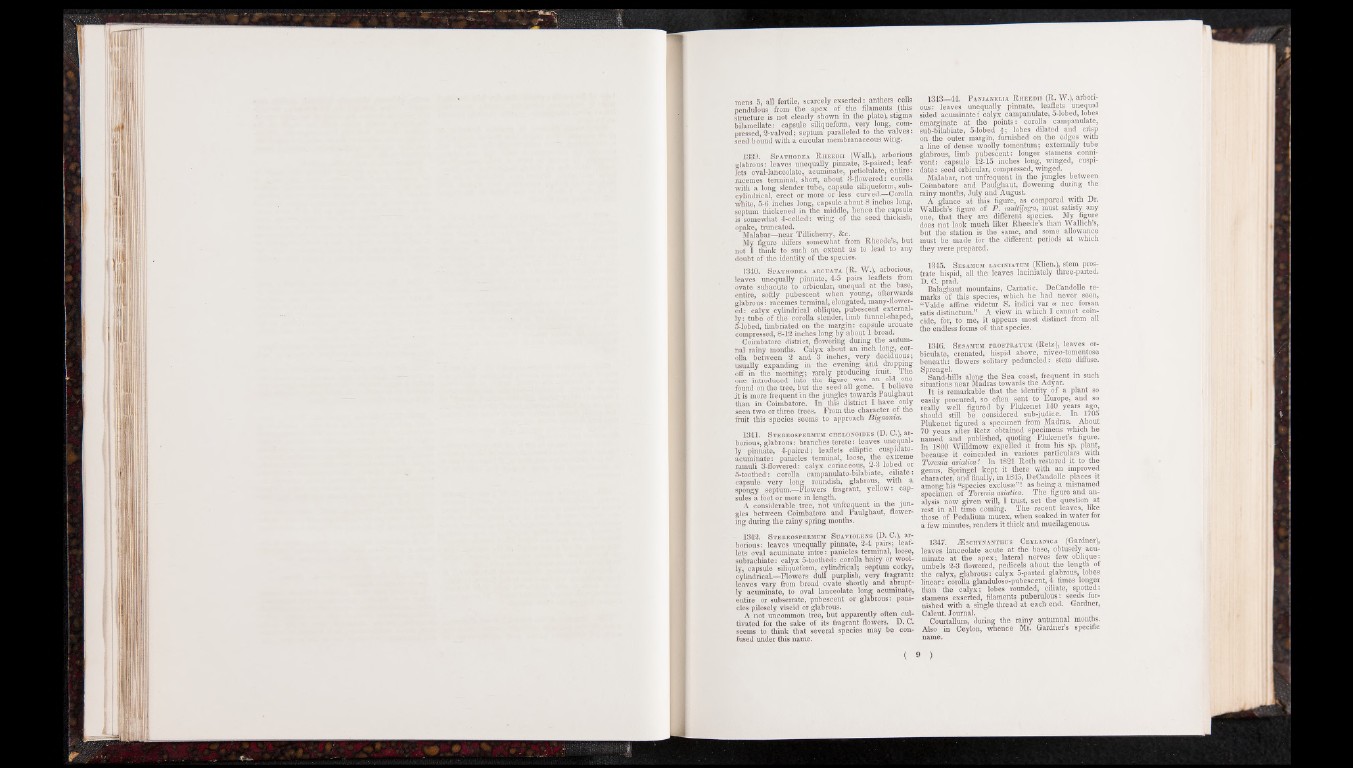
mens 5, all fertile, scarcely exserted: anthers cells
pendulous from the apex of the filaments (this
structure is not clearly shown in the plate), stigma
bilamellate: capsule siliqueform, very long, compressed,
2-valved; septum paralleled to the valves:
seed bound with a circular membranaceous wing.
1339. Spathodea Rheedii (Wall.), arborious
glabrous: leaves unequally pinnate, 3-paired; leaflets
oval-lanceolate, acuminate, petiolulate, entire:
racemes terminal, short, about 3-flowered: corolla
with a long slender tube, capsule siliqueform, sub-
cylindrical, erect or more or less curved.—Corolla
white, 5-6 inches long, capsule about 8 inches long,
septum thickened in the middle, hence the capsule
is somewhat 4-celled: wing of the seed thickish,
opake, truncated. ^
Malabar—near Tillicherry, &c.
My figure differs somewhat from Rheede’s, but
not I think to such an extent as to lead to any
doubt of the identity of the species.
1340. Spathodea arcuata (R. W.), arborious,
leaves unequally pinnate, 4-5 pairs leaflets from
ovate subacute to orbicular, unequal at the base,
entire, softly pubescent when young, afterwards
glabrous: racemes terminal, elongated, many-flowered:
calyx cylindrical oblique, pubescent externally:
tube of the corolla slender, limb funnel-shaped,
5-lobed, fimbriated on the margin: capsule arcuate
compressed, 8-12 inches long by about 1 broad.
Coimbatore district, flowering during the autumnal
rainy months. Calyx about an inch long, corolla
between 2 and 3 inches, very deciduous;
usually expanding in the evening and dropping
off in the morning; rarely producing fruit. The
one introduced into the figure was an old one
found on the tree, but the seed all gone. I believe
it is more frequent in the jungles towards Paulghaut
than in Coimbatore. In this district I have only
seen two or three trees. From the character of the
fruit this species seems to approach Bignonia.
1341. S tereospermum chelonoides (D. C.), arborious,
glabrous: branches terete: leaves unequally
pinnate, 4-paired; leaflets elliptic cuspidato-
acuminate: panicles terminal, loose, the extreme
ramuli 3-flowered: calyx coriaceous, 2-3 lobed or
5-toothed: corolla campanulato-bilabiate, ciliate:
capsule very long roundish, glabrous, with a
spongy septum.—Flowers fragrant, yellow: capsules
a foot or more in length.
A considerable tree, not unfrequent in the jungles
between Coimbatore and Paulghaut, flowering
during the rainy spring months.
1342. S tereospermum S uaviolens (D. C.), arborious:
leaves unequally pinnate, 2-4 pairs; leaflets
oval acuminate intre: panicles terminal, loose,
subrachiate: calyx 5-toothed: corolla hairy or woolly,
capsule siliqueform, cylindrical; septum corky,
cylindrical.—Flowers dull purplish, very fragrant:
leaves vary from broad ovate shortly and abruptly
acuminate, to oval lanceolate long acuminate,
entire or subserrate, pubescent or glabrous: panicles
pilosely viscid or glabrous.
A not uncommon tree, but apparently often cultivated
for the sake of its fragrant flowers. D. C.
seems to think that several species may be confused
under this name.
1343—44. P anjanelia R heedii (R. W.), arborious:
leaves unequally pinnate, leaflets unequal
sided acuminate:“ calyx campanulate, 5-lobed, lobes
emarginate at the points : corolla campanulate,
sub-bilabiate, 5-lobed £; lobes dilated and crisp
on the outer margin, furnished on the edges with
a line of dense woolly tomentum; externally tube
glabrous, limb pubescent: longer stamens conni-
vent: capsule 12-15 inches long, winged, cuspidate
: seed orbicular, compressed, winged.
Malabar, not unfrequent in the jungles between
Coimbatore and Paulghaut, flowering during the
rainy months, July and August.
A glance at this figure, as compared with Dr.
Wallich’s figure of P . multijuga, must satisfy any
one, that they are different species. My figure
does not look much liker Rheede’s than Wallich’s,
but the station is the same, and some allowance
must be made for the different periods at which
they were prepared.
1345. Sesamum laciniatum (Klien.), stem prostrate
hispid, all the leaves laciniately three-parted.
D. C. prad.
Balaghaut mountains, Carnatic. DeCandolle remarks
of this species, which he had never seen,
“Valde affine videtur S. indici var a nec forsan
satis distinctum.” A view in which I cannot coincide,
for, to me, it appears most distinct from all
the endless forms of that species.
1346. S esamum prostratum (Retz), leaves or-
biculate, crenated, hispid above, niveo-tomentose
beneath: flowers solitary peduncled: stem diffuse.
Sprengel.
Sand-hills along the Sea coast, frequent in such
situations near Madras towards the Adyar.
It is remarkable that the identity of a plant so
easily procured, so often sent to Europe, and so
really well figured by Plukenet 140 years ago,
should still be considered sub-judice. In 1705
Plukenet figured a specimen from Madras. About
70 years after Retz obtained specimens which he
named and published, quoting Plukenet’s figure.
In 1800 Willdmow expelled it from his sp. plant,
because it coincided in various particulars with
Torenia asiatica! In 1821 Roth restored it to the
genus, Springel kept it there with an improved
character, and finally, in 1845, DeCandolle places it
among his “species exclusae” ! as being a misnamed
specimen of Torenia asiatica. The figure and analysis
now given will, I trust, set the question at
rest in all time coming. The recent leaves, like
those of Pedalium murex, when soaked in water for
a few minutes, renders it thick and mucilagenous.
1347. JS schynanthus Ceylanica (Gardner),
leaves lanceolate acute at the' base, obtusely acuminate
at the apex; lateral nerves few oblique:
umbels 2-3 flowered, pedicels about the length of
the calyx, glabrous: calyx 5-parted glabrous, lobes
linear: corolla glanduloso-pubescent, 4 times longer
than the calyx; lobes rounded, ciliate, spotted:
stamens exserted, filaments puberulous: seeds furnished
with a single thread at each end. Gardner,
Calcut. Journal.
Courtallum, during the rainy autumnal months.
Also in Ceylon, whence Mr. Gardner’s specific
name.